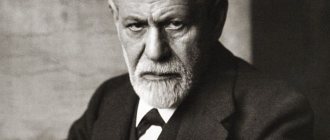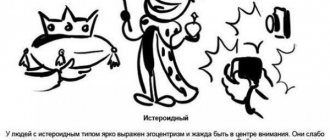The Rosenzweig test is an intermediate link between an apperception test on a given topic and a survey using the word association method. Stimulus pictures are used as material. The simplicity and uniformity of the pictures is used to ensure that the individual being tested gives simple answers, short in content and in detail. The Rosenzweig test technique is distinguished by the objective advantages of word association and retains the characteristic features of the thematic apperception questionnaire.
Content
- 1 Description of the test
- 2 Age limits for using the test
- 3 Theoretical foundations
- 4 Procedure 4.1 Instructions for adults:
- 4.2 Instructions for children:
- 5.1 Evaluation of answers 5.1.1 Description of the semantic content of factors
- 7.1 Protocol form
The impact of frustrating events on a child
It is well known that the occurrence of difficult situations at an early age affects the state of mind and behavior in adulthood. It is impossible to give children the right upbringing if, during their growth and development, they do not find themselves in difficult situations that require mobilizing their strength and making adequate decisions.
From early childhood, a child must learn to resist obstacles and experience reasonable restrictions and deprivations. But the above-mentioned aspects of a child’s existence should not be confused with a period of long-term patience with similar situations created by external reasons or if he is placed in a hopeless situation due to the negative behavior of adults. Such prolonged pathological frustrations experienced in childhood lead to pathogenic personality changes in the future.
Test Description
The test occupies an intermediate place between the word association test and the thematic apperception test. It resembles TAT in that it uses pictures as stimulus material. But unlike TAT pictures, these pictures are very monotonous in nature and, what is more significant, are used in order to obtain from the subject relatively simpler and uncomplicated answers, limited both in length and content. Thus, this technique retains some of the objective advantages of the word association test while at the same time getting closer to the aspects of personality that the TAT seeks to identify.
The technique is intended to study reactions to failure and ways to get out of situations that impede activity or meet the needs of the individual.
The test material consists of a series of 24 drawings representing each character in a frustrating situation. In each drawing on the left, the character is shown uttering words describing the frustrations of another individual or his own. The character on the right has an empty square above him, in which he must write his answer, his words. Characters' features and facial expressions are removed from the drawing to promote identification of those features (projectively). The situations presented in the test can be divided into two main groups.
- A. Situation of obstacle “I” (ego-blocking). In these situations, some obstacle, character or object stops, discourages, confuses, in a word, frustrates the subject in any direct way. There are 16 situations of this type. For example, situation 1.
- B. The situation of the “superego” obstacle (superegoblocking). The subject then serves as the object of the accusation. He is called to account or blamed by others. There are 8 such situations. For example, situation 2. There is a connection between these two types of situations, because the “superegoblocking” situation suggests that it was preceded by a situation of “I” obstacle, where the frustrator was the object of frustration. In exceptional cases, the subject can interpret the situation of obstacle “superself” and vice versa. The subject is given a series of drawings and given the following instructions: “Each of the drawings consists of two or more people. One person is always depicted saying certain words. You need to write in the empty space the first answer to these words that comes to your mind. Don't try to get away with a joke. Act as quickly as possible."
The reservation in the instructions regarding humor did not arise by chance. It is based on all experience using this test. It turned out that the comical responses given by some subjects, and perhaps caused by the cartoonish appearance of the drawing, were difficult to count. An experimental study of this limitation in the instructions may be very interesting. Then they show the subject how to give the answer.
The total test time is recorded. When the test ends, the survey begins. The subject is asked to read his responses one by one, and the experimenter highlights features, such as voice intonation, that allow the responses to be interpreted according to a scoring system. If the answer is short or very rare, the experimenter must clarify its meaning during the interview.
It happens that the subject does not understand the situation well, although in this case the reminder itself may be significant; the survey allows you to get a new answer after the meaning of the situation is explained to the subject
Types of Responses
Rosenzweig divides responses into two types:
- a response corresponding to the continuation of satisfaction of a desire or need , which appears systematically after each frustrating picture;
- response responsible for one's own defense , such a reaction occurs only in the event of a real threat to a person.
When receiving answers of the first type, there is a direction of adaptive persistence, when the subject’s persistence continues and aims to overcome obstacles to get what he wants. There is also non-adaptive persistence, represented by behavior in the form of stupid attacks to achieve an uncertain goal.
There is also an adaptive response in blaming external conditions and defending one's self if the character's response is justified by objective reality. This may be the case if an individual realizes that his insufficient knowledge and skills led to the collapse of the enterprise, and he builds accusations against himself. A reaction is considered maladaptive if the character blames himself, not understanding that the objective reason is the opposition or inaction of other circumstances.
If the first type involves satisfying desires in any way, then in the second case, reactionary responses continue to be divided into three more types and are used as the basis for classification:
- excited and angry responses to external obstacles and the people who created them; some cases are characterized by a gradual increase in the peak of indignation, when aggression is initially hidden, but finds indirect expression.
- answers based on an admission of one’s own guilt and indicating the appearance of remorse;
- reconciliatory responses aimed at coping with the situation peacefully and avoiding reproaches addressed to oneself.
The operator should consider the answers from the point of view of truthfulness and directness; it is such reactions that indicate the desire to continue the initial desires. Symbolic and untruthful answers include the substitutive meaning of the subject’s phrases.
The operator evaluating the test results reviews the answers for adequate reactions. Responses to proposed frustration that satisfy biological requirements are essentially adequate, as are those that promote the development and progress of the individual, as opposed to the process of regression.
Theoretical basis
In 1934, Rosenzweig published a "heuristic" classification of types of frustration reactions, which he intended to be the basis for measuring personality projection. A more advanced formulation of the theory appeared in 1938.
In a situation of frustration, Rosenzweig considers three levels of psychological defense of the body.
- Cellular (immunological) level, psychobiological protection is based here on the action of phagocytes, skin antibodies, etc. and contains exclusively the body’s defense against infectious influences.
- Autonomous level, also called the level of immediate necessity (according to Cannon's typology). It involves the protection of the body as a whole against general physical aggression. Psychologically, this level corresponds to fear, suffering, rage, and physiologically, it corresponds to biological changes such as “stress.”
- The highest cortical level (protection of the “I”) includes the protection of the individual against psychological aggression. This is the level that mainly includes the theory of frustration.
This distinction is, of course, schematic; Rosenzweig emphasizes that, in a broad sense, the theory of frustration covers all three levels and they all interpenetrate each other. For example, a series of mental states: suffering, fear, anxiety, which in principle belong to three levels, actually represent fluctuations; suffering belongs to both levels 1 and 2, fear - to 2 and 3, only anxiety - exclusively to level 3.
Rosenzweig distinguishes two types of frustration.
- Primary frustration, or deprivation. It is formed if the subject is deprived of the opportunity to satisfy his need. Example: hunger caused by prolonged fasting.
- Secondary frustration. It is characterized by the presence of obstacles or opposition on the path leading to the satisfaction of a need.
This definition of frustration refers mainly to secondary frustration, and it is on this that most experimental studies are based. An example of secondary frustration is: a subject, starving, cannot eat because he is disturbed by the arrival of a visitor.
It would be natural to classify frustration reactions according to the nature of the needs suppressed. Rosenzweig believes that the modern lack of classification of needs does not create obstacles to the study of frustration; what is hindered is the lack of knowledge about the frustration reactions themselves, which could become the basis for classification.
When considering thwarted needs, two types of reactions can be distinguished.
- Need continuation response. It occurs constantly after every frustration.
- Self defense reaction. This type of reaction has in mind the fate of the individual as a whole; it arises only in special cases of threat to the individual.
In the reaction of continuation of a need, it aims to satisfy this need in one way or another. In the self-defense reaction, the facts are more complex. Rosenzweig proposed dividing these reactions into three groups and retained this classification as the basis of his test.
- The answers are extrapunitive (outwardly accusing). In them, the subject aggressively blames external obstacles and persons for deprivation. The emotions that accompany these responses are anger and agitation. In some cases, aggression is first hidden, then it finds its indirect expression, responding to the projection mechanism.
- The answers are intrapunitive, or self-blaming. The feelings associated with them are guilt, remorse.
- The answers are impulsive. There is an attempt here to avoid the reproaches expressed by others and to oneself, and to consider this frustrating situation in a reconciling manner.
One can view frustration reactions in terms of their directness. Direct reactions, the response of which is closely related to the frustrating situation and remains a continuation of the initial needs. Reactions are indirect, in which the response is more or less vicarious and, at most, symbolic.
Finally, one can consider reactions to frustrations from the point of view of the adequacy of reactions. In fact, every reaction to frustration, considered from a biological point of view, is adaptive. We can say that reactions are adequate to the extent that they represent progressive tendencies of the personality rather than regressive ones.
In responses to continuation of needs, two extreme types can be distinguished.
- Adaptive persistence. Behavior continues in a straight line despite obstacles.
- Non-adaptive persistence. The behavior is repeated in a vague and stupid way.
There are also two types of “I” defense responses.
- Adaptive response. The answer is justified by existing circumstances. For example, an individual does not have the necessary abilities and fails in his enterprise. If he blames himself for failure, his response is adaptive.
- Maladaptive response. The answer is not justified by the existing circumstances. For example, an individual blames himself for a failure that is actually caused by the mistakes of other people.
One of the important questions is about the types of frustrators. Rosenzweig identifies three types of frustrators.
- He classified deprivation as the first type, i.e. the lack of necessary means to achieve a goal or satisfy a need. There are two types of deprivation - internal and external. As an illustration of “external deprivation,” i.e., the case when the frustrator is located outside the person himself, Rosenzweig cites a situation when a person is hungry but cannot get food. An example of internal deprivation, that is, with a frustrator rooted in the person himself, can be a situation when a person feels attracted to a woman and at the same time realizes that he himself is so unattractive that he cannot count on reciprocity.
- The second type is losses, which are also of two types - internal and external. Examples of external losses are the death of a loved one, loss of home (the house burned down). As an example of internal loss, Rosenzweig gives the following: Samson losing his hair, in which, according to legend, all his strength lay (internal loss).
- The third type of frustrator is conflict: external and internal. To illustrate the case of external conflict, Rosenzweig gives the example of a man who loves a woman who remains faithful to her husband. An example of an internal conflict: a man would like to seduce the woman he loves, but this desire is blocked by the idea of what would happen if someone seduced his mother or sister.
The above typology of situations that provoke frustration raises major objections: the death of a loved one and love episodes are placed on the same level; conflicts that relate to the struggle of motives, to conditions that are often not accompanied by frustration, are unsuccessfully singled out.
However, these remarks aside, it should be said that the mental states of loss, deprivation and conflict are very different. They are far from the same even with various losses, deprivations and conflicts, depending on their content, strength and significance. The individual characteristics of the subject play an important role: the same frustrator can cause completely different reactions in different people.
An active form of manifestation of frustration is also withdrawal into distracting activities that allow one to “forget”.
Along with sthenic manifestations of frustration, there are also asthenic reactions - depressive states.
Depressive states are characterized by feelings of sadness, a sense of uncertainty, powerlessness, and sometimes despair. A special type of depression is a state of stiffness and apathy, a kind of temporary numbness.
Regression
as one of the forms of manifestation of frustration is a return to more primitive, and often infantile forms of behavior, as well as a decrease in the level of activity under the influence of the frustrator.
By highlighting regression as a universal expression of frustration, one should not deny that cases of expression of frustration in a certain primitiveness of experiences and behavior exist (with obstacles, for example, tears).
Like aggression, regression is not necessarily the result of frustration. It can also occur for other reasons.
Emotionality
is also one of the typical forms of frustration.
Frustration varies not only in its psychological content or direction, but also in duration. Characterizing forms of mental state can be short bursts of aggression or depression, or they can be long-lasting moods.
Frustration as a mental state can be:
- typical of a person's character;
- atypical, but expressing the beginning of the emergence of new character traits;
- episodic, transient (for example, aggression is typical for a person who is unrestrained, rude, and depression is typical for a person who lacks self-confidence).
Rosenzweig introduced into his concept a concept of great importance: frustration tolerance, or resistance to frustrating situations.
It is determined by the individual’s ability to tolerate frustration without losing his psychobiological adaptation, that is, without resorting to forms of inadequate responses.
There are different forms of tolerance.
- The most “healthy” and desirable mental state should be considered one that is characterized, despite the presence of frustrators, by calmness, prudence, and a willingness to use what happened as a life lesson, but without any self-complaints.
- Tolerance can be expressed in tension, effort, and inhibition of unwanted impulsive reactions.
- Tolerance is a type of flaunting, with emphasized indifference, which in some cases masks carefully hidden anger or despondency.
In this regard, the question of teaching tolerance arises. Do historical or situational factors lead to frustration tolerance?
It is hypothesized that early frustration influences behavior later in life, both in terms of later frustration reactions and in other aspects of behavior. It is impossible to maintain a normal level of education in a child if, in the gradual course of development, he does not acquire the ability to solve in a favorable way the problems that appear before him: obstacles, restrictions, deprivations. At the same time, there is no need to confuse normal resistance to frustration with tolerance. Frequent negative frustrations in early childhood may later have pathogenic significance. It can be said that one of the tasks of psychotherapy is to help a person discover a past or present source of frustration and teach how to behave in relation to it.
This is, in general terms, Rosenzweig’s theory of frustration, on the basis of which a test was created, first described in 1944 under the name “picture association” test, or “frustration reaction test”.
Types of frustrations
Rosenzweig divides the frustration situations themselves into two types:
- primary difficult situation , when a person does not have even the slightest opportunity to satisfy his own need;
- secondary type of frustration , in which there are certain obstacles on the way to satisfying desires.
The Rosenzweig picture questionnaire is based on the method of placing a subject in a frustration situation of the second category. In this case, the method of intersection of the needs of two characters in the pictures is used. For example, a postal employee cannot eat because he is disturbed by the arrival of a visitor, etc. Even if the classification of difficult situations is completely removed, this will not be a big loss, the psychologist believes. It is important to know about the frustration reactions that form the basis of the classification.
Procedure
In total, the technique consists of 24 schematic contour drawings, which depict two or more people engaged in an unfinished conversation. These drawings are presented to the subject. It is assumed that by “responsible for another”, the subject will express his opinion more easily, more reliably and show typical reactions to get out of conflict situations. The researcher notes the total time of the experiment. The test can be used both individually and in groups. But unlike group research, individual research uses another important technique: asking students to read written answers out loud.
The experimenter notes features of intonation and other things that can help clarify the content of the answer (for example, a sarcastic tone of voice). In addition, the subject may be asked questions regarding very short or ambiguous answers (this is also necessary for scoring). Sometimes it happens that the subject misunderstands a particular situation, and, although such errors in themselves are significant for a qualitative interpretation, after the necessary clarification he must. a new response will be received. The original answer should be crossed out, but not erased. The survey should be conducted as carefully as possible, so that the questions do not contain additional information.
Instructions for adults:
“You will now be shown 24 drawings (application in separate folders). Each of them depicts two people talking. What the first person says is written in the square on the left. Imagine what another person might answer. Write the very first answer that comes to your mind on a piece of paper, labeling it with the corresponding number. Try to work as quickly as possible. Take the task seriously and don't get off with a joke. Don't try to use hints either."
Instructions for children:
“I will show you drawings (application in separate folders) that depict people in a certain situation. The man on the left is saying something and his words are written on top in a square. Imagine what another person might answer. Be serious and don't try to get off with a joke. Think about the situation and respond quickly.”
Disadvantages of Rosenzweig's Picture Poll
The disadvantages include a monotonous generalization of frustration complications, for example, love affairs and the loss of loved ones fall into the general pile. Conflicts related to the struggle between external and internal manifestations are poorly highlighted. Situations in pictures are offered for consideration, which are often difficult to classify as frustrations.
The depth of experiences and mental states is not taken into account. For example, with hardships, losses and conflicts, they are in different weight categories. The strength of the experience depends on the significance for the individual of the semantic load of the situation, on its content. People perceive different life complications depending on their importance; what some will unsettle for a long time, others will consider a small obstacle on the way to their chosen goal.
Processing the results
Test processing consists of the following steps:
- Evaluation of answers
- Definition of the indicator “degree of social adaptability”.
- Definition of profiles.
- Definition of samples.
- Trend analysis.
Evaluation of answers
The test score allows each answer to be reduced to a certain number of symbols that correspond to the theoretical concept. Each answer is evaluated from two points of view.
- To the direction of the reaction expressed by him:
- extrapunitive (E),
- intrapunitive (I),
- impunitive (M).
- Reaction type:
- obstructive-dominant (OD) (the response emphasizes the obstacle that caused the subject's frustration in the form of a comment about its cruelty, in a form that presents it as favorable or insignificant);
- ego-defensive (ED) (“the self of the subject plays the largest role in the answer, and the subject either blames someone, or agrees to answer, or denies responsibility at all);
- necessity-persistent (NP) (the response is aimed at resolving a frustrating situation, and the reaction takes the form of demanding the help of some other person to resolve the situation, the form of accepting the responsibility to make the necessary corrections, or in anticipation of what the normal course of things will bring with time) constitute corrections).
From the combination of these 6 categories, 9 possible scoring factors are obtained.
Each answer can be assessed by one, two, or less often three counting factors.
To denote extrapunitive, intropunitive or impunitive orientation in general, without taking into account the type of reactions, the letter E, I or M is used, respectively. To indicate the obstructive-dominant type, after the capital letters of direction, the sign “prim” ( ) is written - E, I, M. Ego-protective types of extrapunitiveness, intropunity and impunity are indicated by capital letters E, I, M. The need-persistent type is expressed by lowercase letters e, i, m. Each factor is written in the corresponding column opposite the answer number, and its counting value in this case (two recorded indicators on one answer) no longer corresponds to one whole point, as with a single answer indicator, but 0.5 points. A more detailed breakdown of the answer into 3, 4, etc. indicators is possible, but not recommended. In all cases, the total sum of all counting factors with a fully completed protocol is 24 points - one point for each point.
All responses of the subject, coded in the form of counting factors, are recorded on the protocol form in the appropriate columns opposite the counting points.
Counting factors for classifying responses
| Types of reactions | |||
| Direction of reactions | O-D obstructive-dominant | E-D ego-protective | NP need-unsustainable |
| E - extrapunitive | E' - definitely stands out, emphasizing the presence of a frustrating circumstance, an obstacle. | E - accusation. Hostility, etc., manifests itself in relation to the external environment (sometimes sarcasm). The subject actively denies guilt, showing hostility towards the accuser. | e - contains a requirement for another specific person to correct a frustrating situation. |
| I - intropunitive | I' - a frustrating situation is interpreted as favorable or as a deserved punishment, or embarrassment by the concern of others is emphasized. | I - accusation, condemnation the object makes against itself. The subject admits guilt, but denies responsibility, citing mitigating circumstances. | i - the subject, recognizing his responsibility, undertakes to independently correct the situation, to compensate for the losses of another person. |
| M - impulsive | M' - denies the significance or unfavorability of the obstacle, the circumstances of frustration. | M - condemnation of anyone is clearly avoided, the objective culprit of frustration is justified by the subject. | m - the subject hopes for a successful resolution of problems over time; compliance and conformity are characteristic. |
Description of the semantic content of factors
Definition of the indicator “degree of social adaptability”
The indicator of “degree of social adaptation” - GCR - is calculated using a special table. Its numerical value expresses the percentage of coincidence of the counting factors of a particular protocol (in points) with the total number of standard answers for the population.
The number of such points for comparison in the author’s original is 12, in the Russian version (according to N.V. Tarabrina) - 14. Accordingly, the denominator in the fraction when calculating the GCR percentage is the number of standardized points (in the latter case 14), and the numerator is the number of points, received by the subject by coincidence. In the case when the subject’s answer is encoded by two counting factors and only one of them coincides with the normative answer, not a whole point, but 0.5 points is added to the total amount of the numerator of the fraction.
Standard answers for counting are given in the table below.
Standard response values for calculating GCR for adults
| No. | O.D. | ED | NP |
| 1 | M' | E | |
| 2 | I | ||
| 3 | |||
| 4 | |||
| 5 | |||
| 6 | e | ||
| 7 | E | ||
| 8 | |||
| 9 | |||
| 10 | E | ||
| 11 | |||
| 12 | E | ||
| 13 | e | ||
| 14 | |||
| 15 | E' | ||
| 16 | E; I | ||
| 17 | |||
| 18 | E' | e | |
| 19 | I | ||
| 20 | |||
| 21 | |||
| 22 | M' | ||
| 23 | |||
| 24 | M' |
Standard response values for calculating GCR for children
| № | 6-7 years | 8-9 years | 10-11 years | 12-13 years old |
| 1 | ||||
| 2 | E | E/m/ | m | M |
| 3 | E | E; M | ||
| 4 | ||||
| 5 | ||||
| 6 | ||||
| 7 | I | I | I | I |
| 8 | I | I/i | I/i | |
| 9 | ||||
| 10 | M'/E | M | ||
| 11 | I//m | |||
| 12 | E | E | E | E |
| 13 | E | E | I | |
| 14 | M' | M' | M' | M' |
| 15 | I' | EAT' | M' | |
| 16 | E | M'/E | M' | |
| 17 | M | m | e;m | |
| 18 | ||||
| 19 | E | E;I | E;I | |
| 20 | i | i | ||
| 21 | ||||
| 22 | I | I | I | I |
| 23 | ||||
| 24 | m | m | m | M |
Note: the denominator is the number of standard points, the numerator is the number of match points.
Profiles
The total scores of each of the nine scoring factors are recorded in the profile table on the protocol form. The same table indicates the total total score and percentage (out of 24) of all answers for each direction (in a row) and each type (in a column).
Profile table
| Reaction type | O.D. | ED | NP | Sum | % | Std. |
| E | ||||||
| I | ||||||
| M | ||||||
| Sum | ||||||
| % | ||||||
| Std. |
Average test statistics for groups of healthy individuals (in%)
| Author of the study | Direction of reaction | Reaction type | ||||
| E | I | M | O.D. | ED | NP | |
| S. Rosenzweig 75 (9/12) | 40 | 30 | 30 | 20 | 50 | 30 |
| N.V. Tarabrina 62-64 (8/14) | 46-52 | 25-27 | 23-26 | 32-34 | 35-39 | 27-30 |
Standard indicators for categories (in%)
| Age | Categories | |||||
| Direction of reaction | Reaction type | |||||
| E | I | M | 0-D | ED | NP | |
| 6-7 years | 46,3 | 22,1 | 31,3 | 23,8 | 39,6 | 35,8 |
| 8-9 years | 43,3 | 23,3 | 32,9 | 23,3 | 42,1 | 34,2 |
| 10-11 years | 39,2 | 24,6 | 35,8 | 22,9 | 41,7 | 34,6 |
| 12-13 years old | 33,3 | 25,8 | 40,4 | 22,5 | 42,3 | 34,2 |
Average GCR values for children of different ages
| GCR values | Age group | |||
| 6-7 years | 8-9 years | 10-11 years | 12-13 years old | |
| in points | 6,0 | 7,5 | 8,6 | 10,4 |
| V % | 59,9 | 62,6 | 71,3 | 69,2 |
Samples
Based on the profile table, samples are determined.
There are only 4 of them: 3 main and 1 additional.
Sample 1:
Statement of the relative frequency of responses in different directions, regardless of the type of reactions.
Sample 2:
reflects the relative frequency of response types.
Sample 3:
reflects the relative frequency of the most common three factors, regardless of types and directions.
Three basic patterns make it easier to note the predominant modes of response by direction, type, and combination of these.
Additional sample
consists of comparing egoblocking responses with corresponding superegoblocking reactions.
Trend analysis
During the experiment, the subject can noticeably change his behavior, moving from one type or direction of reaction to another. Any such change is of great importance for understanding frustration, since it shows the subject’s attitude towards his own reactions.
For example, a subject may begin the experiment by giving extra-punitive reactions, then after 8 or 9 situations that arouse feelings of guilt in him, begin to give intra-punitive responses.
Analysis involves identifying the existence of such trends and clarifying their nature. Trends are marked (recorded) in the form of an arrow, above the arrow shaft indicate a numerical assessment of the trend, determined by the sign “+” or “-“. “+” is a positive trend, “-” is a negative trend.
Formula for calculating the numerical assessment of trends:
where a is the quantitative assessment in the first half of the protocol; b - quantitative assessment in the second half of the protocol. To be considered representative, a trend must fit into at least 4 responses and have a minimum score of ±0.33.
There are 5 types of trends:
- Type 1 - consider the direction of the reaction on the O - D scale (factors E', I', M'),
- Type 2 - consider the direction of the reaction on the E - D scale (factors E, I, M),
- Type 3 - consider the direction of the reaction on the N - P scale (factors e, i, m),
- Type 4 - consider the direction of the reaction without taking into account the graphs,
- Type 5 - consider the distribution of factors in three columns, without taking into account the direction.
Characteristic features of frustration states
Depressive manifestations of the personality state are classified as asthenic reactions. People subject to sadness, uncertainty, and indifference are often powerless to change anything and become capable of desperate and reckless acts.
Regression is classified as a primitive and infantile state that lowers the threshold of effective activity. In a state of collapse, there are characteristic opportunities to express one’s emotional grief and experience, for example, by going into loneliness or tears. But a period of regression in life can arise not only in frustration; it is sometimes caused by completely different circumstances.
Another standard manifestation is the emotional perception of the situation. When an unusual situation arises, an individual can express his feelings directed at the other participants in the event and do this for quite a long time, even after the complications have stopped. Outbursts of depression or aggression can also be short-lived.
Tolerance or resistance to unusual situations is also a feature of frustration. This component characterizes a person’s ability to withstand and maintain resistance to difficult life circumstances. It manifests itself in the character’s ability to get used to the situation and make a decision without losing psychological balance, and not give inappropriate answers when conducting a picture survey.
Interpretation of results
The subject more or less consciously identifies himself with the frustrated character in each situation of the technique. Based on this provision, the resulting response profile is considered characteristic of the subject himself. The advantages of S. Rosenzweig's technique include high test-retest reliability and the ability to be adapted to different ethnic populations.
The substantive characteristics of individual indicators of the methodology, theoretically described by the author, basically correspond to their direct meanings described in the section for calculating indicators. S. Rosenzweig noted that the individual reactions recorded in the test themselves are not a sign of “norm” or “pathology”; in this case, they are neutral. The total indicators, their general profile and compliance with the standard standards of the group are significant for interpretation. The last of these criteria, according to the author, is a sign of the adaptability of the subject’s behavior to the social environment. The test indicators do not reflect structural personality formations, but individual dynamic characteristics of behavior, and therefore this instrument did not imply psychopathological diagnosis. However, a satisfactory discriminative ability of the test was found in relation to groups of suicides, cancer patients, sexual maniacs, the elderly, the blind, and stutterers, which confirms the advisability of its use as part of a battery of instruments for diagnostic purposes.
It is noted that high extrapunitiveness in the test is often associated with inadequate increased demands on the environment and insufficient self-criticism. An increase in extra-punitivity is observed in subjects after social or physical stressors. Among offenders, there appears to be a camouflaged underestimation of extrapunitiveness relative to norms.
An increased indicator of intropunity usually indicates excessive self-criticism or uncertainty of the subject, a reduced or unstable level of general self-esteem (Borozdina L.V., Rusakov S.V., 1983). In patients with asthenic syndrome, this figure is especially high.
The dominance of impulsive reactions means the desire to resolve the conflict and hush up an awkward situation.
Types of reactions and GCR indicators that differ from standard data are characteristic of persons with deviations in various areas of social adaptation, in particular with neuroses.
The trends recorded in the protocol characterize the dynamics and effectiveness of the subject’s reflexive regulation of his behavior in a situation of frustration. According to some authors, the severity of tendencies in the test is associated with instability and internal conflict of the demonstrated standard of behavior.
When interpreting the results of using the test as the only research tool, one should adhere to the correct description of the dynamic characteristics and refrain from drawing conclusions that claim diagnostic value.
The principles for interpreting test data are the same for children's and adult forms of the S. Rosenzweig test. It is based on the idea that the subject consciously or unconsciously identifies himself with the character depicted in the picture and therefore, in his answers, expresses the characteristics of his own “verbal aggressive behavior.”
Each category and factor included in the summary profile has a certain meaning, which follows from the theoretical ideas about frustration that underlie the design of this test.
As a rule, all factors are represented to one degree or another in the profile of most subjects. A “full” profile of frustration reactions with a relatively proportional distribution of values among factors and categories indicates a person’s ability for flexible, adaptive behavior, the ability to use various ways to overcome difficulties, in accordance with the conditions of the situation. On the contrary, the absence of any factors in the profile indicates that the appropriate methods of behavior, even if they are potentially available to the subject, will most likely not be implemented in situations of frustration.
The profile of frustration reactions of each person is individual, however, it is possible to identify common features characteristic of the behavior of most people in frustrating situations.
Analysis of the indicators recorded in the profile of frustration reactions also involves comparing the data of the individual profile with normative values. In this case, it is established how well the values of the categories and factors of the individual profile correspond to the average group indicators, and whether there is an exit beyond the upper and lower limits of the permissible interval.
So, for example, if an individual protocol indicates a low value of category E, a normal value of I and a high M (all in comparison with normative data), then on this basis we can conclude that this subject in situations of frustration tends to downplay the traumatic, unpleasant aspects of these situations and inhibit aggressive manifestations directed towards others where others usually express their demands in an extrapunitive manner.
The value of extrapunitive category E that exceeds the standards is an indicator of increased demands made by the subject on others, and can serve as one of the indirect signs of inadequate self-esteem.
A high value of intropunitive category I, on the contrary, reflects the subject’s tendency to place excessively high demands on himself in terms of self-accusation or taking on increased responsibility, which is also considered as an indicator of inadequate self-esteem, primarily its decrease.
Categories characterizing the types of reactions are also analyzed taking into account their content and compliance with standard indicators. Category 0-D (fixation on an obstacle) shows the extent to which the subject tends to focus on the existing obstacle in situations of frustration. If the 0-D score exceeds the established normative limit, then it should be assumed that the subject is inclined to fixate excessively on the obstacle. Obviously, the increase in the 0-D score occurs due to a decrease in the ED N-P scores, i.e., more active types of attitude towards the obstacle. The ED rating (fixation on self-defense) in the interpretation of S. Rosenzweig means the strength or weakness of the “I”. Accordingly, an increase in the ED indicator characterizes a weak, vulnerable, vulnerable personality, forced in situations of obstacles to focus primarily on protecting one’s own “I”.
The NP assessment (fixation on need satisfaction), according to S. Rosenzweig, is a sign of an adequate response to frustration and shows to what extent the subject shows frustration tolerance and is able to solve the problem that has arisen.
The overall assessment of the categories is supplemented by characteristics for individual factors, which makes it possible to establish the contribution of each of them to the total indicator and more accurately describe the ways in which the subject reacts in situations of obstacles. An increase (or, conversely, a decrease) in the rating for any category may be associated with an overestimated (or, accordingly, underestimated) value of one or more of its constituent factors.
Types of exacerbations in frustrating situations
The psychologist groups all complications that arise in life situations according to the type of manifestation.
Deprivation
A situation arises when there are no opportunities to achieve a certain satisfaction at a specific moment. When processing the results, it is taken into account that deprivations can be external and internal. External factors can interfere with the satisfaction of needs, for example, in personal life, if a person is in places where people of the opposite sex are absent for objective reasons. Internal frustration can move directly into the human personality if, in the same situation of the need to communicate with the opposite sex, a person realizes his own inadequacy in appearance and spiritual plane and cannot attract anyone for mutual contact.
Losses
This type of complication is also divided into internal and external types. External circumstances are manifested by the loss of home, work, financing, sudden death of loved ones and relatives for reasons beyond the control of the individual. Internal hardships include physical losses, for example, paralysis of limbs or hearing loss, aging of the body, and other diseases. Mental losses also become part of the group of internal losses, such as long-term depression, the appearance of mistrust, and lack of optimism.
Conflict
This type of frustration complications includes the emergence of a conflict between external and internal manifestations. Conflict means the impossibility of committing a legal or illegal action, associating it with a similar case in circumstances external to the individual and trying the consequences on oneself or loved ones. For example, a person wants to take an object that does not belong to him, that is, commit theft. But he is stopped by the thought that this could happen to his family and they will experience a feeling of grief.
Adult version
| Types of reactions | |||
| Direction of reactions | O-D obstructive-dominant | E-D ego-protective | NP need-unsustainable |
| E - extrapunitive | E'. If the answer emphasizes the presence of an obstacle. For example: “It’s raining heavily outside. My raincoat was very useful." (Fig.9). “And I expected that she and I would go together.” (8). Occurs mainly in situations with an obstacle. | E. Hostility and censure are directed against someone or something in the environment. Example: “it’s the height of the workday, and your manager is not there.” (9). “The mechanism is worn out, they can’t be made new.” (5). “We’re leaving, it’s her own fault.” (14). E. The subject actively denies his guilt for the offense committed. Example: “The hospital is full of people, what do I have to do with it?” (21) | f. It is required, expected, or explicitly implied that someone must resolve the situation. Example: “Anyway, you must find this book for me.” (18). "She could tell us what's going on." (20). |
| I - intropunitive | I'. A frustrating situation is interpreted as favorable-profitable-useful, as bringing satisfaction. Example: “It will be even easier for me alone.” (15). “But now I will have time to finish reading the book.” (24). | I. Blame, condemnation is directed at oneself, the feeling of guilt, one’s own inferiority, and remorse dominates. Example: “I came at the wrong time again” (13). JL The subject, while admitting guilt, denies responsibility, invoking mitigating circumstances. Example: “But today is a day off, there are no children here, and I’m in a hurry.” (19) | i. The subject himself undertakes to resolve the frustrating situation, openly admitting or hinting at his guilt. Example: “I’ll get out of it somehow.” (15). "I will do my best to atone for my guilt." (12). |
| M - impulsive | M'. The difficulties of a frustrating situation are not noticed or are reduced to its complete denial. Example: “I’m late, I’m so late.” (4). | M. The responsibility of a person who finds himself in a frustrating situation is reduced to a minimum, and condemnation is avoided. Example: “We couldn’t know that the car would break down.” (4). | m. The hope is expressed that time, the normal course of events, will resolve the problem, you just need to wait a little, or that mutual understanding and mutual compliance will eliminate the frustrating situation. Example: “Let’s wait another 5 minutes.” (14). “It would be good if this didn’t happen again.” (1 1). |









